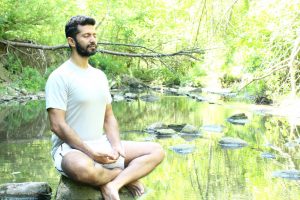Something that’s come up a lot around our Shala lately is the theme of meditation. Many practitioners have shared their desire to learn how to meditate, but have no idea where to start, or feel that it’s way too difficult.
Sitting still with our breath, our emotions, and our feelings can be challenging for a group of people who show up each morning to undergo the rigorous Ashtanga practice. We’re so used to jumping through, turning our bodies into pretzels, and bending (sometimes) gracefully backwards onto our hands, that the idea of sitting still may seem impossible. And while the practice is technically a moving meditation, simply going through the motions of the Asanas doesn’t necessarily mean you’re using it that way.
I went to Purple Valley with David on one of his retreats a few years back. In one of his talks he said, (I’m paraphrasing here), “I can’t actually tell if any of you are good at yoga.”
I’m pretty sure all the people who had spent hours learning to float, and do handstands to impress him on this trip were pissed.
But he went on to say that the depth of yoga isn’t in any asana. It’s not in your ability to float or do a handstand either. It’s a state of mind; a way of being. One of focused, concentrated attention where the mind is still. And as an outsider, you can’t really see that state of mind. So the ability to perform advanced asana doesn’t mean anything if you aren’t able to harness the essence of the practice.
After all, asana without breath is just shitty gymnastics.

While Asana is one of the limbs of yoga, Dhyana (meditation) is another limb. One that challenges you in different ways than asana.
Incorporating meditation into your life in addition to your yoga practice can have a host of benefits such as:
- Helping you connect more with, and deepen your breath during practice
- Supporting you in dealing with difficult emotions on the mat (because let’s be honest, they will come up)
- Stress reduction
- Vagus nerve stimulation
People ask me all the time how to start a meditation practice, and while it isn’t necessarily easy, it’s actually quite simple.
Here’s 3 simple things you can do to get yourself started with meditation.

1. Take a few extra minutes at the end of your practice to sit quietly.
This is perhaps the simplest way for the regimented Ashtangi to get started. If you have the tapas to show up every day, get on your mat, and do your whole practice, then you have the tapas to give yourself even 5 minutes after your practice to just sit in stillness. This is simple, but NOT easy.
Start by focusing on your breath. At this point in your practice, you and your breath should be best buds, and the transition may be seamless. But if it’s feel difficult, that’s ok. Notice thoughts, feelings, and emotions that come up. Let them be there, but continue to bring your awareness back to your breath. Sometimes I like to count 30 deep breaths to culminate my practice, that way I don’t need to keep a timer. Pick a number and start there. There’s no wrong way to do this. You can increase this number as you
2. Use The Breathing App
Ashtanga’s own Eddie Stern has created and launched an awesome app called “The Breathing App.” I’ve been using it for a while now, and I have to say it’s both incredibly awesome and challenging. For any Ashtangi who’s looking to work on pranayama, or looking for a simple app to start a meditation practice, this one is awesome!
The way it works is you pick a breath ratio. You can use the traditional Ashtanga count of 5:5; though I find the 5:7 ratio more natural in a sedentary practice personally. Then you pick a total duration for you meditation. I started with 10 minutes, but you can start as low as one minute and work your way up! It’s so simple, and yet incredibly challenging to sustain attention and focus. It really works your mindful muscles, and can have an incredible impact on your health.
If you’ve ever heard Eddie talk about the Vagus Nerve (aka Sushumna Nadi as Guruji said) you will know he is a wealth of information on this topic. And if you have no idea what I am talking about, watch this video where Eddie discusses how deep breathing can improve Vagus Nerve stimulation with Deepak Chopra. No biggie. Just Deepak himself.
Eddie says that using this app for even 5-10 minutes a day can have a cumulative effect on your health and well-being.
3.Try mindful walking or eating!
While sitting and watching your breath are great forms of meditation, mindfulness and paying attention aren’t just reserved for sitting. You can totally reap the benefits of this practice while walking, or eating (my personal favourite way of meditating). You can pretty much pick any simple, daily task, bring your full attention to it, and that my friends, is your meditation. I mean, we jump around on a mat, put our legs behind our head, and pretzel our bodies into crazy shapes and call that a form of meditation right? So why can’t walking, eating, or doing your laundry be the same?
To start, each day pick one thing, and commit to doing this with complete attention and awareness. It can literally be anything. Notice your breath. Notice any thoughts, feelings or distractions as they come up, and keep bringing your attention back to what you’re doing.
I hope these tips were helpful in helping you find some yoga off your mat! Do you meditate outside of your asana practice? How do you practice yoga off the mat? Let us know how in the comments below!

So how did you know that this form of being is fruitful?
Perhaps the greatest measure is your daily life and interaction with others … e.g. are your relationships with others better or are you still prone to tantrums etc.
If you meditate long enough, seemingly the well will run dry or you’ll have peaks and valleys during this time. Consistency is the key.